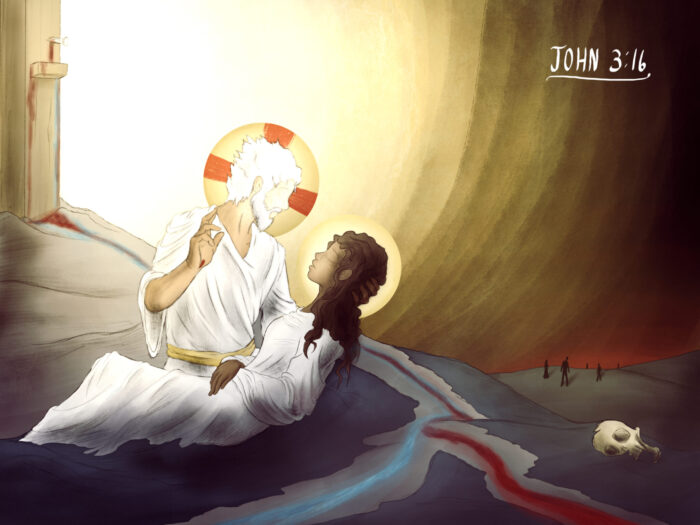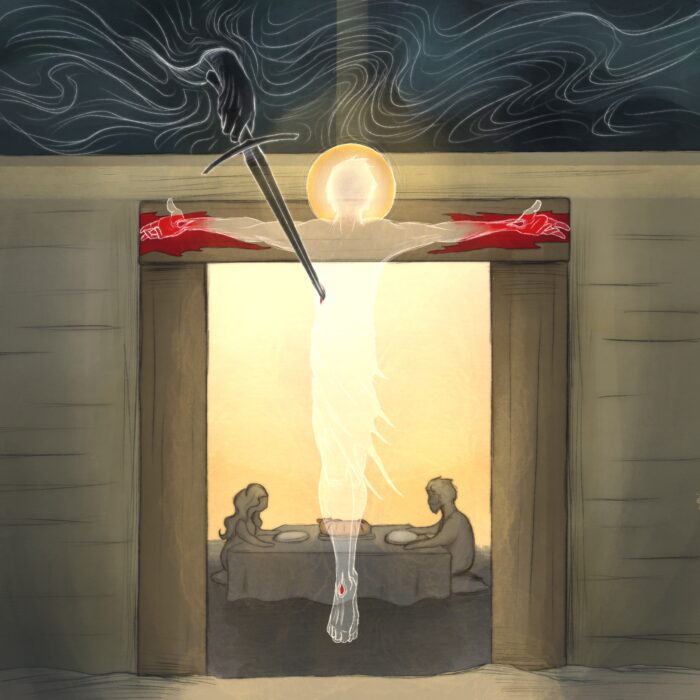
John 1:1, “In the beginning was the Word, and the Word was with God, and the Word was God.”
John 1:14, “And the Word became flesh, and dwelt among us, and we have seen His glory, glory as of the only Son from the Father, full of grace and truth.”
John 1:29, “Behold the Lamb of God who takes away the sins of the world.”
The Passage Considered
While much could and ought to be said about these three verses, all I want to do is draw attention to a single concept that their conjunction highlights; namely, that the eternal, self-revealing Word of God who is Himself God (1:1) was born as a fully human child (1:14) in order to die as the Lamb who takes away the sins of the world (1:29). God becomes a zygote, God becomes an embryo, God becomes a developing fetus in the womb of a young Jewish virgin, and God is born to that virgin and named Jesus, because—as Matthew tells us—He will save His people from their sins (Matthew 1:21).
And how will He do this? How will the God-Man save His people from their sins? By becoming the “Lamb of God” who bears them away in Himself and is offered up as a sacrifice on their behalf. Yes, when the Word becomes flesh, God the Son irreversibly takes the fullness of human nature to Himself so that He might have a body in which to bear our sins (1 Peter 2:24), and blood with which to satisfy the wrath that they deserve, ransoming us from sin’s tyranny in this life (1 Peter 1:18-19) and its punishment in the next (Revelation 5:9-10).
And how does one appropriate this work? How are we—as sinners—to know that God is this for me? Only in obedience to the command of John in 1:29; only as we behold—by faith—the crucified and risen Lamb of God who takes away the sins of the world and, in beholding, fall down and confess with Thomas, “My Lord and my God” (John 20:28)!
The Picture Considered
In this picture the “word becoming flesh,” is depicted by the words “I Am” pouring down from heaven into the form of the infant Jesus. Why did I represent the incarnation in this way? To answer this question, I need to ask and try to answer another: why did John introduce us to the eternal Son of God as the “Word”?
We could fruitfully and faithfully point to the significance that the “Logos” plays in Greek philosophy, however, I think the supreme reason that the Son is called the “Word” finds its rationale in the Old Testament. All throughout scripture, YHWH reveals Himself, declares Himself, manifests Himself by His Word (two paradigmatic examples being Exodus 3:14-15, and 33:18-19, 34:6-7). He is a speaking God, and only because He has spoken do we know Him.
Thus, when John introduces the Son as the “Word,” He is introducing Him as the one who reveals God. And because “in the beginning” this Word already “was,” we are driven to conclude that the Word is not merely the revelation of God to creation, but—in some sense—even to God Himself. The Word is, as it were, God’s eternal, self-disclosing “I Am” spoken by Himself, to Himself within Himself before the foundation of the world. And now, John 1:14 tells us, this Word who is God himself internally declared has taken on flesh and dwelt in our midst. It is as if God has taken His own eternally spoken “I Am” and translated it into the language of a human life: Jesus of Nazareth. Jesus, John tells us in 1:18, is the final “exegesis” (unfolding, making known) of the invisible God; the one who perfectly makes God known because He is Himself perfect God. In Him, God’s own Name—YHWH, I Am (Exodus 3:114-15)—finds climactic and definitive revelation.
But then, see that the “I Am” of God’s perfect self-revelation flows not only into the form of the infant Christ, but also—from Christ—into the form of the slain Lamb. Notice also that the darkness that surrounds the entire image is being swallowed up into the wound in the Lamb’s neck. Jesus Christ, God incarnate, is the Lamb of God who takes away the sins of the world by bearing them in His own body on the tree (1 Peter 2:24), by becoming them on the cross (2 Corinthians 5:21). He who is Himself God, offers Himself up to God, through the eternal Spirit of God, as the Lamb provided by God (Genesis 22:13-14, John 1:29, 34, Hebrews 9:14). Hallowed be His Name!
The self-disclosing Word of God who is God is wholly translated into the language of the man Jesus of Nazareth so that, in Him, we might perfectly know God (1 John 5:20). The desire behind this image is to help us consider afresh that when we “read” this flawless translation of God’s Identity, we find as its climax the God-Man dying as a Lamb slain for the sins of rebels and enemies. That is the Word of the Cross whereby we know God and so are saved; that is the “foolishness” that decimates human pride; that is the “weakness” that overthrows the powers of this world; that is the glory that philosophy could never imagine, the beauty that saves the world.
In summary, the truly stunning truth about the Word of the Cross is not only that God has thus saved us, but that in thus saving us, God has definitively communicated Himself to us. Jesus is not merely the one who saves us from our sins, He is—and more primarily—the one who, in saving us from our sins, reveals to us the God for whom we are saved. The unified testimony of scripture teaches that we are redeemed in order to know and enjoy God, and the glorious reality of the gospel is this: The crucified and risen Jesus Christ by whose person and work we are saved is Himself the supreme revelation of the God whom we are redeemed in order to know and enjoy. Redemption is revelation.




